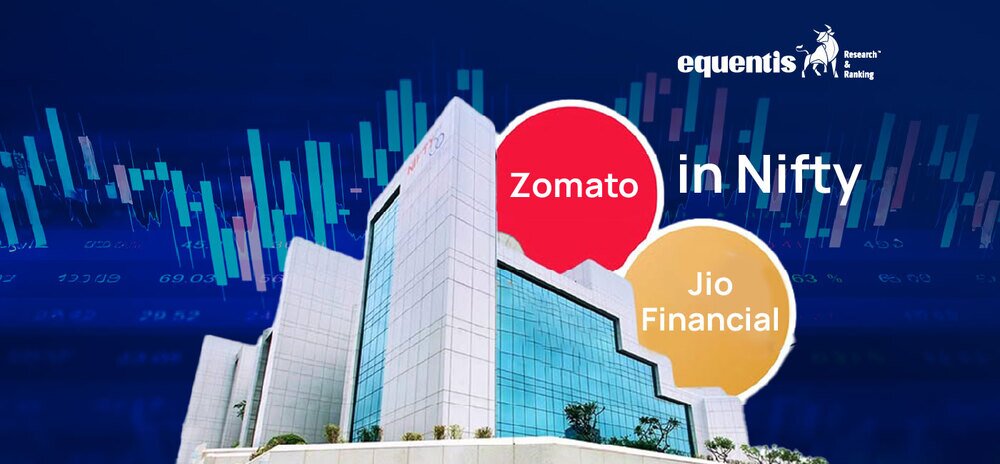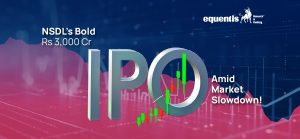After a sluggish start, the primary market indices picked up the pace and closed green for the day. While the indices rebounded during the trading session, NIFTY50 rebalanced its constituents and is ready to welcome two major companies in the 50-pack index- Zomato Limited and Jio Financial Services Limited.
As an effect of this shift, the share price of the two companies saw positive movements when the market opened on 27th March 2025. However, the shift is also said to have attracted over $900 million in passive inflows and drove the index PE (price-to-equity ratio). How? Let’s understand.
NIFTY50 Revaluation
The NIFTY50 index is a benchmark for the Indian stock market, representing the performance of the top 50 largest and most liquid Indian companies listed on the National Stock Exchange of India (NSE). To ensure accurate representation, NSE rebalances the constituents regularly, meaning that companies that no longer meet these criteria are removed while others that qualify are added.
The recent rebalancing in March 2025 led to Zomato Limited replacing Bharat Petroleum Corporation Limited (BPCL), and Jio Financial Services Limited replacing Britannia Industries as the NIFTY50 index constituents effective 28th March 2025.
Meeting The Eligibility Criteria:
Zomato Limited and Jio Financial Services Limited met the four main criteria set by NSE to make it in the 50-pack index.
- Market Impact Cost: The stock must have an average impact cost of 0.50% or less over the past six months for at least 90% of the observations, based on a trade value of Rs.100 million.
- F&O Segment Eligibility: The company’s stock must be actively traded in the Futures & Options (F&O) segment.
- Minimum Listing History: While some sources indicate a required listing period of six months, others suggest one month as the cutoff.
- Free-Float Market Capitalization: A company’s average free-float market cap should be at least 1.5 times the smallest constituent in the index. The index undergoes semi-annual rebalancing to reflect market dynamics.
For Zomato Limited, the following developments led to the inclusion in NIFTY50-
- Revenue Growth: The company’s revenue surged from Rs.2,605 crore (March 2020) to Rs.12,114 crore (March 2024), demonstrating a strong 5-year CAGR of over 40%.
- Profitability: After years of reporting losses, Zomato turned profitable, recording a net profit of Rs.351 crore in March 2024.
- Market Capitalization: As of its inclusion in March 2025, Zomato’s market cap ranged between Rs.202,465 crore to Rs.216,650 crore, with an average free-float market capitalization of Rs.1,69,837 crore- well above the required threshold.
In the case of Jio Financial Services, although a relatively new listing post-demerger from Reliance Industries, Jio Financial Services (JFS) quickly demonstrated its strength in the financial sector.
- Revenue & Profitability: The company reported a revenue of Rs.638.06 crore and a net profit of Rs.382.47 crore in FY2024, establishing early financial stability.
- Market Capitalization: JFS’s market cap ranged from Rs.1,41,293 crore to Rs.1,44,568.98 crore, with an average free-float market capitalization of Rs.1,04,387 crore- again exceeding the NSE’s minimum requirement.
Effects Of Revaluation:
a. Investment Inflows:
The inclusion of Zomato and JFS in the NIFTY50 index has led to significant passive fund inflows. This means that the other related index funds and ETFs, to keep mirroring the benchmark, adjust their holdings accordingly to match the updated index, leading to automatic buying of newly included stocks and selling of those being replaced. As a result,
- Zomato is expected to attract $602 million worth of inflows, corresponding to the purchase of $245.3 million shares.
- Jio Financial Services may see around $308 million in inflows from passive investment funds.
- Britannia Industries and BPCL, which were removed from the index, are estimated to witness outflows of $238 million and $225 million, respectively. Source: LiveMint
b. Impact on NIFTY50’s PE Ratio
The PE ratio measures the market’s company valuation relative to its earnings. Adding high-PE stocks like Zomato and JFS has raised the NIFTY50’s overall PE ratio, as they replaced lower-PE stocks.
Before the inclusion, the NIFTY50 index traded at a PE ratio 19.9x, based on estimated earnings per share (EPS) of Rs.1,186 for FY26. For FY27, the index was projected to trade at a PE of 17.5x, with an estimated EPS of Rs.1,349.
Following the inclusion of Zomato and JFS, Nuvama Institutional Equities revised its projections:
- The NIFTY50 PE ratio for FY26 is expected to rise from 19.9x to 20.2x, as the EPS estimate decreases from Rs.1,186 to Rs.1,171.
- For FY27, the PE ratio is projected to increase from 17.5x to 17.7x, with the EPS estimate falling from Rs.1,349 to Rs.1,335. Source: LiveMint
c. Stock Price Movements Post-Inclusion Announcement
The market reaction to the index rebalancing was reflected in the stock price movements of the newly included companies leading up to their official inclusion.
Zomato’s share price rose by 2.68% to reach Rs.208.75 per share on March 27, 2025, the day before its official inclusion.
Jio Financial Services witnessed a 1.95% increase, touching Rs.226.75 per share on the same day.
This price movement indicates investor anticipation of increased demand from passive funds. While index inclusions generally lead to a short-term positive reaction in stock prices, long-term performance depends on broader market conditions, financial results, and investor sentiment.
Bottomline:
The rebalancing has influenced passive fund inflows, raised the overall PE ratio of the index, and triggered stock price movements. While such changes may impact market dynamics in the short term, long-term trends depend on factors such as company performance, economic conditions, and investor sentiment. It is thus essential to keep a close watch on the market conditions and conduct thorough research to understand the market shifts.
Related Posts
Disclaimer Note: The securities quoted, if any, are for illustration only and are not recommendatory. This article is for education purposes only and shall not be considered as a recommendation or investment advice by Equentis – Research & Ranking. We will not be liable for any losses that may occur. Investments in the securities market are subject to market risks. Read all the related documents carefully before investing. Registration granted by SEBI, membership of BASL & the certification from NISM in no way guarantee the performance of the intermediary or provide any assurance of returns to investors.
FAQs
What is PE ratio?
The Price-to-Earnings (PE) ratio is a financial metric that measures how much investors are willing to pay for each unit of a company’s earnings.
What is the F&O Segment?
F&O stands for Futures & Options, derivative instruments that allow traders to speculate on or hedge against price movements of underlying assets like stocks, indices, or commodities.
How does index rebalancing affect the PE ratio?
When high-PE stocks replace low-PE stocks in an index like NIFTY50, the overall PE ratio of the index increases, signaling a shift toward companies with higher growth expectations.
How useful was this post?
Click on a star to rate it!
Average rating 3.5 / 5. Vote count: 2
No votes so far! Be the first to rate this post.
I’m Archana R. Chettiar, an experienced content creator with
an affinity for writing on personal finance and other financial content. I
love to write on equity investing, retirement, managing money, and more.
- Archana Chettiar






















